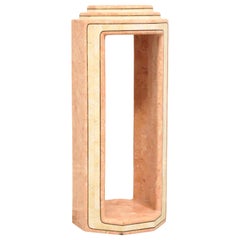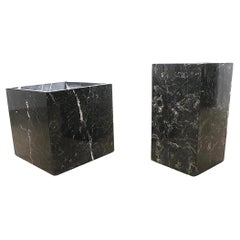Staffordshire Building and Garden Elements
Thanks to its reserves of clay, lead, salt and coal, Staffordshire, England, has been a center for ceramics since the early 17th century. The county was home at one time to hundreds of pottery workshops and as many as 4,000 bottle-shaped kilns that operated year-round. The term “Staffordshire Potteries” refers to the industrial area of Stoke-on-Trent — comprising the towns Burslem, Fenton, Hanley, Longton, Stoke and Tunstall — where most of the production was concentrated.
In 1720, potter John Astbury discovered that he could make what would later be called creamware by adding ground flint powder to the local red clay. Because resources were so plentiful in Staffordshire, local potters could afford to experiment, working to refine their techniques and designs. One such innovator was Thomas Whieldon, an important 18th-century potter known today for his tortoiseshell ware, whose brilliant glazed surface of caramel, yellow and green hues was made with copper and manganese compounds.
Whieldon operated the Fenton Low workshop, making coffee- and teapots, dinner services and even ornamental knife hafts. He was an influential figure: Josiah Spode apprenticed at the workshop prior to opening his company in 1770, and Josiah Wedgwood partnered with Whieldon for five years before establishing his eponymous firm in 1759.
Wedgwood is perhaps the best known of the Staffordshire potters. The firm produced a line of light-colored earthenware for Queen Charlotte, who liked it so much that she granted permission to market it under the moniker Queen’s Ware, which despite the name, was designed for everyday use.
In the same regal vein, in 1773, Wedgwood created the 954-piece Frog service for Catherine the Great, of Russia. The company is also known for its black stoneware, Black Basalt, which imitates the color and shapes of Etruscan vases; Jasperware, with its classical reliefs applied on the unglazed body; and pearlware.
By the end of the 18th century, Staffordshire was the primary producer of ceramics for the American colonies, even creating patriotic wares celebrating independence for this market. The imagery on Staffordshire ceramics became more standardized during the mid-18th century with the advent of transferware, in which a design etched on a copper plate is printed on tissue paper, which is then used to transfer the wet ink onto the ceramic surface. This technique enabled artisans to decorate their wares with complex scenes that wrapped around an object’s surface and make several copies of popular patterns.
The Staffordshire potters also produced decorative figurines, such as this charming pair of cows dating from the 19th century. Particularly popular in Great Britain were pieces with hunting imagery, such as this George IV porcelain stirrup cup in the shape of a fox head wearing a gilt collar inscribed with the word “Tallyho.” Among the many whimsical vessels produced is this mid-19th-century frog mug. The exterior is painted with a charming scene of people picking fruit on one side and ladies on a garden swing on the other side, while inside a molded frog’s head at the bottom of the mug makes a gurgling sound when the beverage has been almost completely consumed.
On 1stDibs, find a range of antique ceramics from the Staffordshire Potteries including decorative objects, tea sets, dinner plates and other items.
Mid-20th Century British Mid-Century Modern Staffordshire Building and Garden Elements
Ceramic
Late 20th Century American Art Deco Staffordshire Building and Garden Elements
Marble
Mid-20th Century Italian Post-Modern Staffordshire Building and Garden Elements
Marble
Early 20th Century Art Deco Staffordshire Building and Garden Elements
Iron
Early 20th Century British Staffordshire Building and Garden Elements
Pine
Late 20th Century American Art Deco Staffordshire Building and Garden Elements
Aluminum
20th Century Art Deco Staffordshire Building and Garden Elements
Copper, Iron
Early 1900s French Louis XV Antique Staffordshire Building and Garden Elements
Giltwood
Late 20th Century American Art Deco Staffordshire Building and Garden Elements
Marble
Mid-20th Century German Mid-Century Modern Staffordshire Building and Garden Elements
Ceramic
21st Century and Contemporary Italian Minimalist Staffordshire Building and Garden Elements
Oak
Mid-20th Century French Staffordshire Building and Garden Elements
Cement
1960s American Hollywood Regency Vintage Staffordshire Building and Garden Elements
Brass
Staffordshire building and garden elements for sale on 1stDibs.
- 1stDibs ExpertMarch 13, 2024To date Staffordshire pottery, look for the maker's mark on the bottom or interior. Then, use trusted online resources to determine the maker and find out when it was active. If you need assistance, have a certified appraiser or knowledgeable antiques dealer examine your pottery. On 1stDibs, find a selection of Staffordshire pottery.
- Is Staffordshire pottery marked?1 Answer1stDibs ExpertApril 5, 2022Almost all Staffordshire pottery and porcelain features a potter’s mark or symbol. One of the most common varieties is the Staffordshire knot, which is a three-loop knot sometimes accompanied by initials and a crown. On 1stDibs, you’ll find a collection of vintage and contemporary Staffordshire pottery from some of the world’s top dealers.
- 1stDibs ExpertApril 5, 2022You can typically spot Staffordshire pottery by locating the potter’s mark or symbol. One of the most common varieties is the Staffordshire knot, which is a three-loop knot sometimes accompanied by initials and a crown. Shop a collection of vintage and contemporary Staffordshire pottery from some of the world’s top sellers on 1stDibs.
- 1stDibs ExpertApril 5, 2022No. In fact, most Staffordshire figurines are not marked. Staffordshire figurines made from 1740 to the mid-1900s don’t generally have a maker’s mark, since they were produced by unknown, small manufacturers. Those manufactured by Kent between 1944 and 1962 feature a black printed mark that reads “Staffordshire Ware Kent Made in England.” Shop a collection of Staffordshire figurines from top sellers on 1stDibs.
- 1stDibs ExpertMarch 22, 2022To tell if Staffordshire figurines are real, turn them over. An authentic Staffordshire will have a hole in the base due to the press-molded firing technique. Also, artisans hand-painted the figurines, so no two ever show off the exact same variations in color. Staffordshire didn't add maker's marks to their pieces. If you see a name on a decorative object, it is unlikely to be authentic. Find a collection of expertly vetted Staffordshire figurines on 1stDibs.
- 1stDibs ExpertApril 5, 2022There are a few signs to look for to authenticate an antique Staffordshire dog figurine. Antique figurines are press molded and feature a small hole in the base, rather than a larger one. The quality of the painting is highly detailed and gilded detail may be worn a bit with age. It is always best to have a professional verify if your figurine is authentic. Shop a range of expertly vetted Staffordshire dog figures on 1stDibs.


